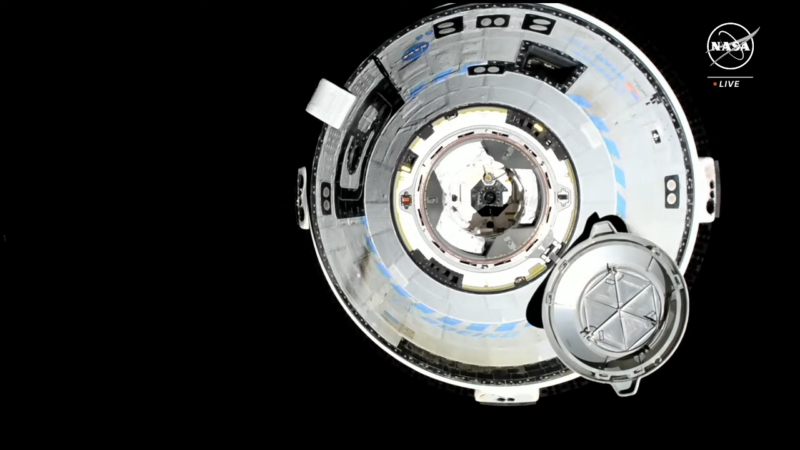
NASA TV
Just a little greater than a day after launching into area, Boeing’s Starliner spacecraft flew as much as the Worldwide House Station and docked with the orbiting laboratory on Thursday
The journey via area was not at all times simple. Within the instant hours after launch on Wednesday, the spacecraft was beset by two helium leaks in its propulsion system. Then, on Thursday, a number of of Starliner’s spacecraft thrusters went offline for a time. Way more usually than initially deliberate, spacecraft commander Butch Wilmore needed to take guide management of Starliner whereas engineers on the bottom labored on these and different points.
Nonetheless, at 1:34 pm ET on Thursday, Wilmore and the mission’s different crew member, Suni Williams, efficiently docked with the area station. A few hours later, they floated via the hatch, making a triumphant entry onto the station—and making historical past.
With Thursday’s success, Boeing turned solely the second personal firm to construct and fly a human orbital spacecraft, becoming a member of an elite membership of simply three nations: Russia, america, and China, alongside SpaceX. For the primary time in historical past, three totally different crewed autos, Starliner, SpaceX’s Dragon, and Russia’s Soyuz, had been all concurrently docked on the station.
“We achieved lots, and actually greater than anticipated,” mentioned Mark Nappi, vp and supervisor of Boeing’s Business Crew Program, throughout a post-docking information convention. “We simply had an impressive day.”
Helium leaks
Earlier than Wednesday’s launch, Boeing and NASA had been already managing a helium leak in one of many eight manifolds that pressurize Starliner’s propulsion system. Nonetheless, a number of hours after launch, two extra leaks had been found. Then, one other one was discovered after Starliner reached the area station.
Throughout the information convention, officers had been at pains to clarify that Starliner nonetheless had a substantial extra of helium on board and that they weren’t involved about these points affecting Starliner’s flight again to Earth. Nonetheless, they acknowledged that these leaks seemed to be a extra systemic drawback than initially believed.
NASA and Boeing engineers, previous to launch, mentioned the preliminary leak was possible attributable to a faulty gasket and that altering a seal would repair it. Boeing opted not to do that as a result of it might have delayed the launch for a number of weeks, and so they labored to persuade NASA it was a manageable concern.
Now, with 4 separate leaks, Nappi acknowledged that Boeing might not absolutely perceive the basis reason for the issue. “They’re very comparable in the best way that they’re behaving, so there’s a superb cause to consider that they could be comparable,” he mentioned Thursday. The corporate has already begun investigating the difficulty with comparable {hardware} on the bottom.
Thruster points
The flight’s different important drawback developed on Thursday, simply hours earlier than Starliner was attributable to dock on the station. This was the failure of 5 of the automobile’s 28 reaction-control system thrusters at sure occasions. These small thrusters are used for high quality pointing and maneuvering, particularly near the area station.
Throughout a troubleshooting course of, wherein the thrusters had been basically reset and fired once more, 4 of the 5 thrusters got here again on-line. This gave NASA confidence to permit Starliner to strategy and finally dock with the area station.
Nonetheless, that is now the second consecutive mission wherein a subset of those small thrusters did not function throughout a Starliner flight. Throughout the automobile’s earlier mission, Orbital Flight Check-2 in Could 2022, a few of these identical thrusters did not function when referred to as upon throughout the strategy to the station. Though two small software program fixes had been utilized after that flight, they seem to not have addressed the difficulty.
“I feel we’re lacking one thing elementary that’s occurring contained in the thrusters,” mentioned Steve Stich, NASA’s industrial crew program supervisor on Thursday. Nonetheless, he and Nappi additionally mentioned they believed that the failure of the thrusters was possible attributable to a “information concern” reasonably than the thruster {hardware} or software program.
Stich declined to invest about how lengthy it might take to review and resolve the thruster concern as a part of the certification course of essential to clear Starliner for operational crewed missions to the Worldwide House Station. Boeing is contracted to fly six of those missions, every carrying 4 astronauts for six-month increments on the station between now and 2030.
Coming house
NASA and Boeing need to spend the following couple of days assessing information collected throughout Starliner’s flight to the station to find out whether or not any extra checks are wanted earlier than Starliner undocks and returns to Earth with Wilmore and Williams. This might occur as quickly as June 14 however is also delayed, Stich mentioned.
Undocking, initiating a de-orbit burn, and surviving reentry via Earth’s environment can be one of the difficult components of the Starliner mission. Two sources advised Ars on Thursday night that NASA had a variety of points to work via earlier than Starliner could be cleared to fly house. Each helium provides and the reaction-control thrusters are mandatory for a profitable departure from the station and entry into Earth’s environment.
Nonetheless, the Boeing official talking to reporters on Thursday, Nappi, sought to downplay the severity of the problems confronted by Starliner and its flight controllers. There are two major issues, he mentioned, the helium leak and the intermittent thruster issues.
“These are fairly small, actually, points to cope with,” he mentioned. “We’ll determine them out for the following mission. I don’t see these as important in any respect.”
